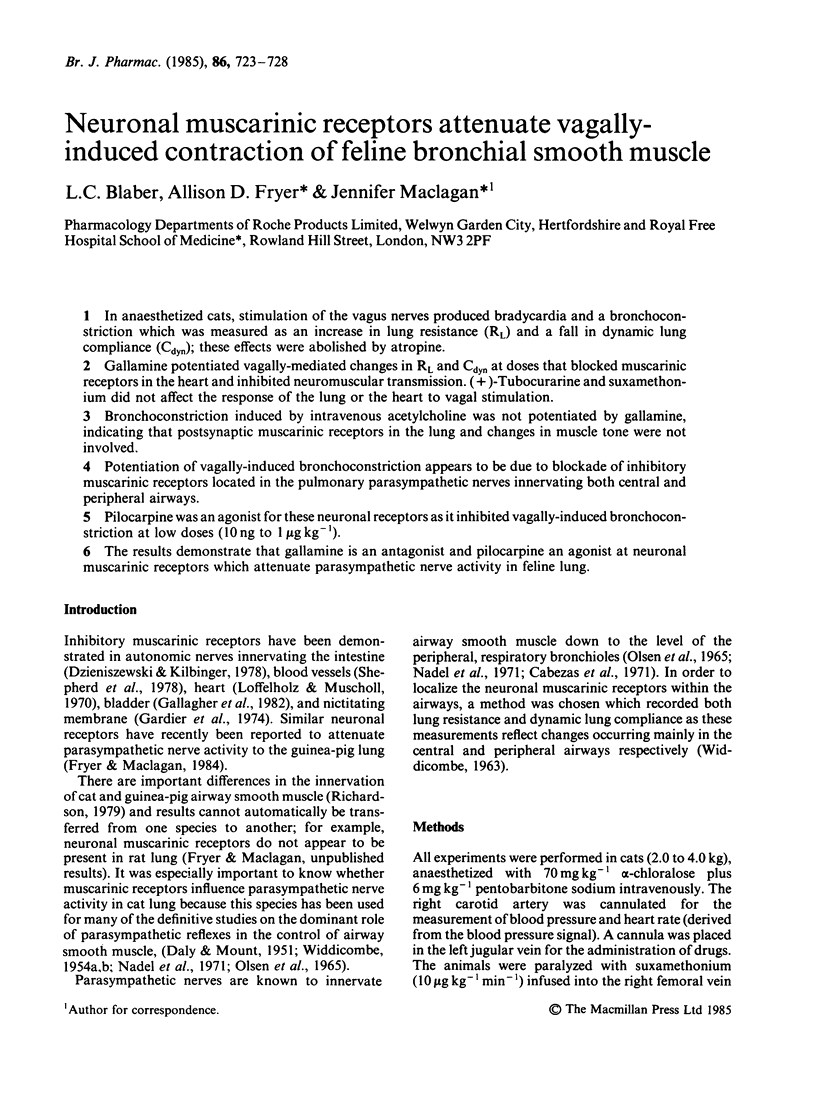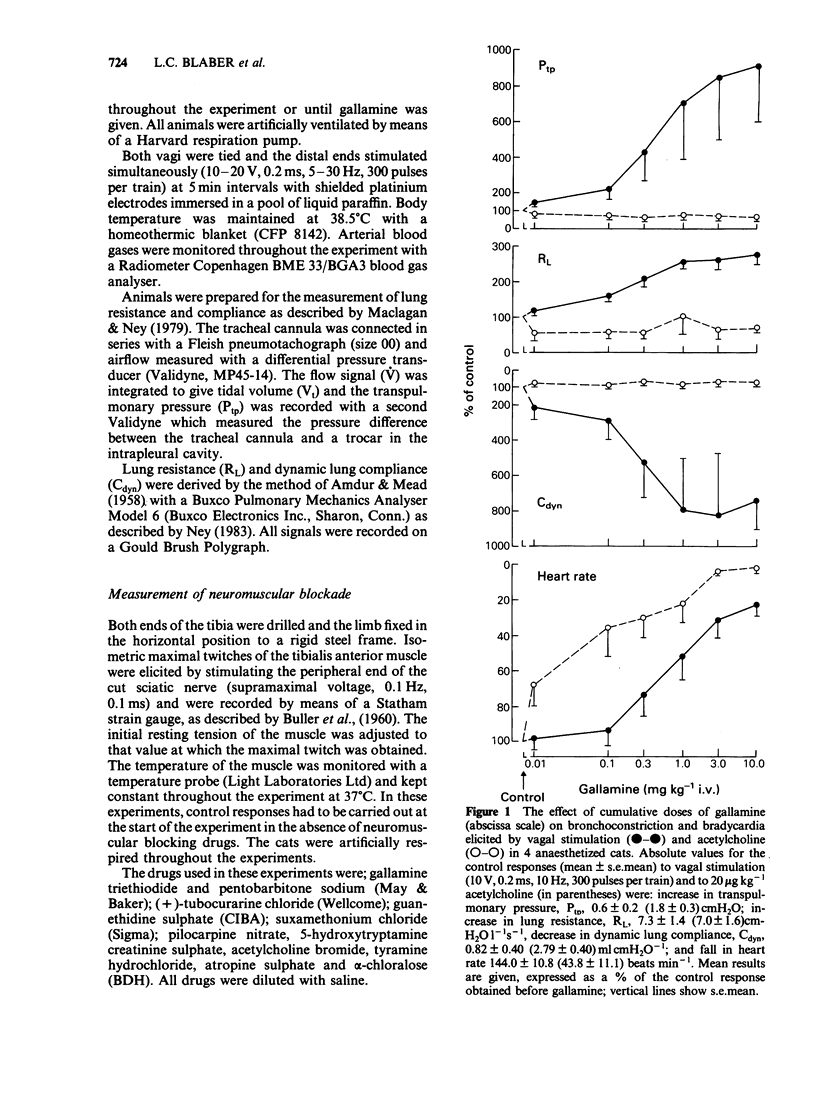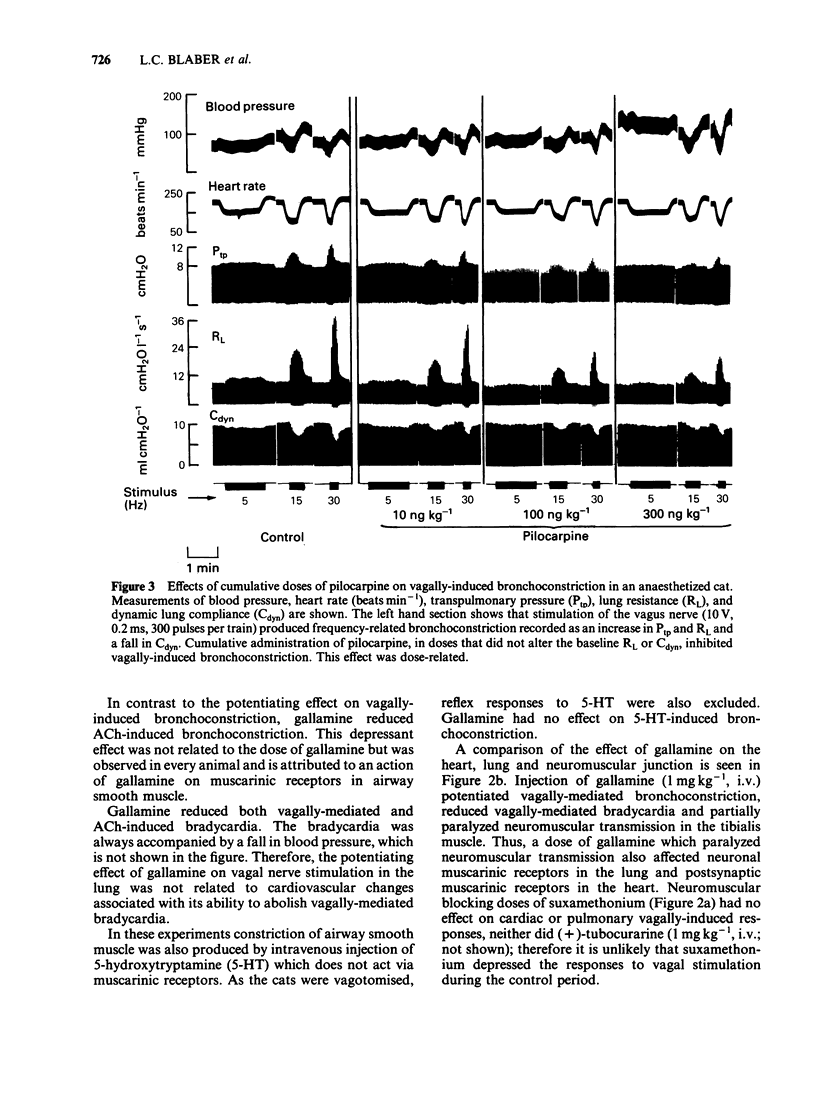Abstract
In anaesthetized cats, stimulation of the vagus nerves produced bradycardia and a bronchoconstriction which was measured as an increase in lung resistance (RL) and a fall in dynamic lung compliance (Cdyn); these effects were abolished by atropine. Gallamine potentiated vagally-mediated changes in RL and Cdyn at doses that blocked muscarinic receptors in the heart and inhibited neuromuscular transmission. (+)-Tubocurarine and suxamethonium did not affect the response of the lung or the heart to vagal stimulation. Bronchoconstriction induced by intravenous acetylcholine was not potentiated by gallamine, indicating that postsynaptic muscarinic receptors in the lung and changes in muscle tone were not involved. Potentiation of vagally-induced bronchoconstriction appears to be due to blockade of inhibitory muscarinic receptors located in the pulmonary parasympathetic nerves innervating both central and peripheral airways. Pilocarpine was an agonist for these neuronal receptors as it inhibited vagally-induced bronchoconstriction at low doses (10 ng to 1 microgram kg-1). The results demonstrate that gallamine is an antagonist and pilocarpine an agonist at neuronal muscarinic receptors which attenuate parasympathetic nerve activity in feline lung.
Full text
PDF





Selected References
These references are in PubMed. This may not be the complete list of references from this article.
- AMDUR M. O., MEAD J. Mechanics of respiration in unanesthetized guinea pigs. Am J Physiol. 1958 Feb;192(2):364–368. doi: 10.1152/ajplegacy.1958.192.2.364. [DOI] [PubMed] [Google Scholar]
- Ashe J. H., Yarosh C. A. Differential and selective antagonism of the slow-inhibitory postsynaptic potential and slow-excitatory postsynaptic potential by gallamine and pirenzepine in the superior cervical ganglion of the rabbit. Neuropharmacology. 1984 Nov;23(11):1321–1329. doi: 10.1016/0028-3908(84)90053-4. [DOI] [PubMed] [Google Scholar]
- BULLER A. J., ECCLES J. C., ECCLES R. M. Differentiation of fast and slow muscles in the cat hind limb. J Physiol. 1960 Feb;150:399–416. doi: 10.1113/jphysiol.1960.sp006394. [DOI] [PMC free article] [PubMed] [Google Scholar]
- Cabezas G. A., Graf P. D., Nadel J. A. Sympathetic versus parasympathetic nervous regulation of airways in dogs. J Appl Physiol. 1971 Nov;31(5):651–655. doi: 10.1152/jappl.1971.31.5.651. [DOI] [PubMed] [Google Scholar]
- Colebatch H. J., Engel L. A. Constriction of the lung by histamine before and after adrenalectomy in cats. J Appl Physiol. 1974 Dec;37(6):798–805. doi: 10.1152/jappl.1974.37.6.798. [DOI] [PubMed] [Google Scholar]
- DALY M. de B., MOUNT L. E. The origin, course and nature of bronchomotor fibers in the cervical sympathetic nerve of the cat. J Physiol. 1951 Mar;113(1):43–62. doi: 10.1113/jphysiol.1951.sp004555. [DOI] [PMC free article] [PubMed] [Google Scholar]
- Dzieniszewski P., Kilbinger H. Muscarinic modulation of acetylcholine release evoked by dimethylphenylpiperazinium and high potassium from guinea-pig myenteric plexus. Eur J Pharmacol. 1978 Aug 15;50(4):385–391. doi: 10.1016/0014-2999(78)90144-9. [DOI] [PubMed] [Google Scholar]
- Fryer A. D., Maclagan J. Muscarinic inhibitory receptors in pulmonary parasympathetic nerves in the guinea-pig. Br J Pharmacol. 1984 Dec;83(4):973–978. doi: 10.1111/j.1476-5381.1984.tb16539.x. [DOI] [PMC free article] [PubMed] [Google Scholar]
- Gallagher J. P., Griffith W. H., Shinnick-Gallagher P. Cholinergic transmission in cat parasympathetic ganglia. J Physiol. 1982 Nov;332:473–486. doi: 10.1113/jphysiol.1982.sp014425. [DOI] [PMC free article] [PubMed] [Google Scholar]
- Gardier R. W., Ganansia M. F., Delaunois A. L., Hamelberg W. Enhancement of ganglionic muscarinic activity by gallamine. Anesthesiology. 1974 May;40(5):494–497. doi: 10.1097/00000542-197405000-00016. [DOI] [PubMed] [Google Scholar]
- Gardier R. W., Tsevdos E. J., Jackson D. B. The effect of pancuronium and gallamine on muscarinic transmission in the superior cervical ganglion. J Pharmacol Exp Ther. 1978 Jan;204(1):46–53. [PubMed] [Google Scholar]
- Gross N. J., Skorodin M. S. Anticholinergic, antimuscarinic bronchodilators. Am Rev Respir Dis. 1984 May;129(5):856–870. doi: 10.1164/arrd.1984.129.5.856. [DOI] [PubMed] [Google Scholar]
- Karczewski W., Widdicombe J. G. The effect of vagotomy, vagal cooling and efferent vagal stimulation on breathing and lung mechanics of rabbits. J Physiol. 1969 Apr;201(2):259–270. doi: 10.1113/jphysiol.1969.sp008754. [DOI] [PMC free article] [PubMed] [Google Scholar]
- Langley J. N. On the Physiology of the Salivary Secretion: Part II. On the Mutual Antagonism of Atropin and Pilocarpin, having especial reference to their relations in the Sub-maxillary Gland of the Cat. J Physiol. 1878 Sep 25;1(4-5):339–369. doi: 10.1113/jphysiol.1878.sp000028. [DOI] [PMC free article] [PubMed] [Google Scholar]
- Libet B., Tosaka T. Dopamine as a synaptic transmitter and modulator in sympathetic ganglia: a different mode of synaptic action. Proc Natl Acad Sci U S A. 1970 Oct;67(2):667–673. doi: 10.1073/pnas.67.2.667. [DOI] [PMC free article] [PubMed] [Google Scholar]
- Löffelholz K., Muscholl E. Inhibition by parasympathetic nerve stimulation of the release of the adrenergic transmitter. Naunyn Schmiedebergs Arch Pharmakol. 1970;267(2):181–184. doi: 10.1007/BF00999400. [DOI] [PubMed] [Google Scholar]
- Maclagan J., Ney U. M. Investigation of the mechanism of propranolol-induced bronchoconstriction. Br J Pharmacol. 1979 Jul;66(3):409–418. doi: 10.1111/j.1476-5381.1979.tb10846.x. [DOI] [PMC free article] [PubMed] [Google Scholar]
- Mills J. E., Sellick H., Widdicombe J. G. Activity of lung irritant receptors in pulmonary microembolism, anaphylaxis and drug-induced bronchoconstrictions. J Physiol. 1969 Aug;203(2):337–357. doi: 10.1113/jphysiol.1969.sp008867. [DOI] [PMC free article] [PubMed] [Google Scholar]
- NADEL J. A., WIDDICOMBE J. G. Effect of changes in blood gas tensions and carotid sinus pressure on tracheal volume and total lung resistance to airflow. J Physiol. 1962 Aug;163:13–33. doi: 10.1113/jphysiol.1962.sp006956. [DOI] [PMC free article] [PubMed] [Google Scholar]
- Nadel J. A., Cabezas G. A., Austin J. H. In vivo roentgenographic examination of parasympathetic innervation of small airways. Use of powdered tantalum and a fine focal spot x-ray tube. Invest Radiol. 1971 Jan-Feb;6(1):9–17. doi: 10.1097/00004424-197101000-00002. [DOI] [PubMed] [Google Scholar]
- Ney U. M. Propranolol-induced airway hyperreactivity in guinea-pigs. Br J Pharmacol. 1983 Aug;79(4):1003–1009. doi: 10.1111/j.1476-5381.1983.tb10548.x. [DOI] [PMC free article] [PubMed] [Google Scholar]
- Richardson J. B. Nerve supply to the lungs. Am Rev Respir Dis. 1979 May;119(5):785–802. doi: 10.1164/arrd.1979.119.5.785. [DOI] [PubMed] [Google Scholar]
- WIDDICOMBE J. G. Regulation of tracheobronchial smooth muscle. Physiol Rev. 1963 Jan;43:1–37. doi: 10.1152/physrev.1963.43.1.1. [DOI] [PubMed] [Google Scholar]
- WIDDICOMBE J. G. Respiratory reflexes excited by inflation of the lungs. J Physiol. 1954 Jan;123(1):105–115. doi: 10.1113/jphysiol.1954.sp005035. [DOI] [PMC free article] [PubMed] [Google Scholar]
- WIDDICOMBE J. G. Respiratory reflexes from the trachea and bronchi of the cat. J Physiol. 1954 Jan;123(1):55–70. doi: 10.1113/jphysiol.1954.sp005033. [DOI] [PMC free article] [PubMed] [Google Scholar]


